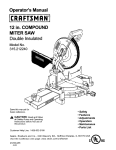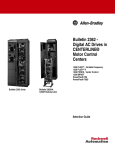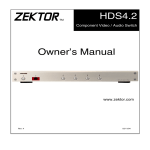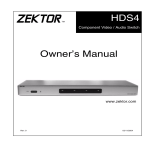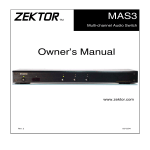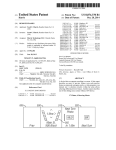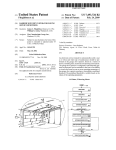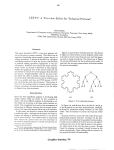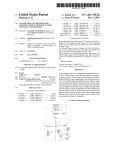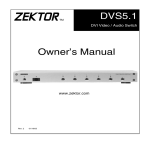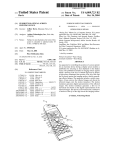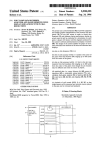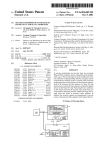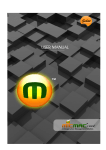Download ? 2 g 4
Transcript
US008365219B2 (12) United States Patent (10) Patent N0.: Harris (45) Date of Patent: (54) REMOTE FRAMES (75) Inventor: (56) . US- PATENT DOCUMENTS , Asslgnee? Harms Technology: LLC, Rancho Santa 5,815,145 A * 9/1998 Matthews, Ill ............... .. 725/41 6,693,652 B1* 2/2004 Barrus et al. ..... .. 715/838 2008/0183843 A1* 7/2008 Gavin et al. ...... .. 709/217 Zoos/0187231 A1* 3/2003 Barbierietal, ,,,,,,,,,,,,, ,, 332/225 Fe, CA (US) * ( . ) _ Nonce' . OTHER PUBLICATIONS - - - Nevo User Manual, Mar. 14, 2010. SubJeCt to any dlsclalmer’ the term Ofthls Patent 15 extended or adJusted under 35 U~S~C- 15403) by 443 days~ (21) Appl. No.: 12/723,653 Flled: P rzmar ' y Exammer ' ' ' D S a l tare 11'1 * D omimc Mar‘ 14’ 2010 (65) (74) Attorney, Agent, or Firm * LaW O?ice of Scott C. Harris, Inc. (57) Prior Publication Data Us 2011/0221964 A1 (51) Pronto Edit Professional, User Manual, Mar. 14, 2010. Logitech Harmony 900 User Manual, Mar. 14, 2010. Universal Remote MX-980 user manual, Mar. 14, 2010. * cited by examiner _ (22) Jan. 29, 2013 References Cited Scott C. Harris, Rancho Santa Fe, CA (US) (73) US 8,365,219 B2 Sep' 15’ 2011 ABSTRACT A device that can operate according to a menu. A ?rst aspect describes an array of preview frames Were each preview Int. Cl. frame can represent a program such as a video program or an H04N 5/445 (2006.01) intranet site. A selection Window Within the array alloWs (52) US. Cl. ....................................................... .. 725/40 (58) Field of Classi?cation Search ................... .. 725/40 selectin3 different revieW frames' Another asP ect_ describes _ _ P ' use Ofthls Shdmg array system Wlthm a GPS deme See application ?le for complete search history. 17 Claims, 4 Drawing Sheets TV lm\ NEH? ? 2 g 4 “5e? tamer“ “ML-m5 \wi US. Patent Jan. 29, 2013 Sheet 2 of4 47% US 8,365,219 B2 (4% 241225 THE HARSH WINE was (PG,ELAPSEE 2% mm) CHANNEL 1?, HQ Fig, 5A F 7, ’/4@!~’ m2 , US. Patent Jan. 29, 2013 Sheet 3 of4 US 8,365,219 B2 US. Patent Jan. 29, 2013 Pimz‘a ef\ “inside Building“ \ Sheet 4 of4 US 8,365,219 B2 US 8,365,219 B2 1 2 According to another embodiment, the television may REMOTE FRAMES itself have a video recording function eg a digital video recorder function, and the memory 110 may be a hard drive that stores many GBs or TBs of video information. In a ?rst embodiment, the key frames of a video may be BACKGROUND Many different devices are controlled using remote con trols. For example, a television device or other kind of media stored, for example, as part of an operation of decompressing incoming information from the cable or network. For player is often controlled by remote control. Other electronic devices including household appliances, or any other kind of example, MPEG compression schemes may store keyframes and other information that changes values between the key device, are often controlled in the same way. Many electronic devices may be dif?cult or impossible to control from the frames. Yet another embodiment may analyZe the content of the video program. For example, this may analyZe all the content device itself, thereby only allowing control via the remote. Therefore, the remote control becomes much more sophisti cated. In contrast, the controls that are controllable from the within a window of 3 to 20 seconds, and ?nd a “frame” which has the best depiction of some aspect within that window/time device (e. g, the television) itself may be less sophisticated. period. For example, usually television shows attempt to depict people in various scenes. The system may analyZe the Universal remotes can be used to control many different devices. SUMMARY 20 The present application describes techniques including menus for electronic devices. Another embodiment describes a new way of controlling devices using remote controls. Another embodiment describes use of these remote control techniques to allow more information to be viewed from a 25 smaller screen. BRIEF DESCRIPTION OF THE DRAWINGS 30 or via some other network control such as WiFi, or some video device 100 being controlled by a remote control; combination thereof. In one embodiment, certain frames FIG. 2 shows an embodiment of using a remote control for which are stored on the television are transferred to the fast forward and/or fast backward; 35 channel selection; remote. In this embodiment, the remote also has a screen 155, and the frames 111 may be shown on this screen. These frames may provide the ability to navigate forward or back ward. FIG. 4 shows how information can be displayed over other windows; The remote also has a user interface that can be a cursor that FIGS. 5A and 5B show an embodiment with a sliding selection window over a larger array of preview frames; FIGS. 6 and 7 show an embodiment for analyZing the frame of the video to use for previews or the like. The television also communicates with a remote device eg a remote control 150. The remote produces an output which commands another device, here the TV or set top box to display different viewable content or take some other action. The communication may be one-way from the remote to the television, or bidirectional. The communication can be by infrared, short range RF control such as WiFi or Bluetooth, FIG. 1 shows a basic embodiment of a television or other FIG. 3 shows an embodiment of using a remote control for content of the frames and de?ne the frame that has the best depiction of a person. For example this may use face analysis to ?nd the face in the scene, and select that face which is closest to the center of the scene in the majority of the frames, for example. This may use more sophisticated techniques, such as information associated with the video that indicates which parts of the video are most important, e.g., coordinates 40 is moved using a trackball joystick or other conventional user interface movement device. Alternatively, the user interface to determine content therein to ?nd a reduced siZe preview can use or include a touch screen. frame; For example, consider the situation where you are watch ing a television. Because of a distraction, or for any other FIG. 8 shows a GPS embodiment; FIG. 9 shows different photographs that can be viewed 45 according to the GPS embodiment; A TV 100 and/ or set top box may store certain content for that purpose. Frames that are stored on the television may be transferred to the remote include an appropriate selection of FIG. 10 shows an inside walking embodiment. DETAILED DESCRIPTION 50 FIG. 1 shows a video device, here television 100 being controlled by a remote control 150. In the embodiment, the television 100 receives input from a source of viewable con tent, e.g., video programming, 105 eg cable or network or a line from a set top box 101 such as a Tivo or DVD or Bluray reason, a user missed some dialog, the user may want to jump back so that you can re-hear what’s been said and re-view it. 55 player. In this embodiment, the television 100 or set top box is itself capable of storing at least some amount of time of the information. For example, the television or the set top box may be able frames. A selection of frames will enable ?nding a frame that would enable an appropriate jump to a desired frame, eg all frames within 5 minutes might enable a jump to anywhere within that 5 minutes. These frames that are sent and viewed herein are referred to as preview frames. For example, FIG. 2 shows a detail of the contents for a time jump screen 199 on the screen 155 of the remote 150. In this embodiment, frames may be provided showing content of what would be shown on the TV screen for one second for ward or a one second back skip; for a 5 second forward or to store certain frames or times of information in a memory 60 back 10 seconds, 30 seconds, or others. Selecting any of these 110. Embodiments may do this to enable a so-called freeZe frames enables moving forward in time, or back in time by a certain amount of time. A selection such as 201 of a frame frame operation or a digital video recording function, or to do such as 200 causes the amount of time associated with that a live tv pause, or a 5-30 second review, for example. The memory 110 may also be able to store for example many frames 111 of information eg separated information, or the like. In one embodiment, this may store a number of key frames within a compressed video system. frame to be displayed as 205, prior to selection of that frame. 65 One embodiment may only allow skipping backwards by certain amounts of time. In the embodiment described above and shown in FIG. 2, the ability to go forward in time may be US 8,365,219 B2 3 4 possible because “time shifted” TV is being watched, for there may be people around the item. The screen 630 may be example when a person is watching 10 minutes behind. When a conventional screen that you would see in an advertisement. watching time shifted TV in this way, the watching position Each of these screens may be analyZed by a video proces sor shown at 640 which may ?nd the proper portion of the screen to display as the preview frame. The processor may use the ?owchart shown in FIG. 7. In FIG. 7, at 700, the processor may determine if there is writing on the screen, and if so by using OCR techniques or can actually move forward by certain times, e. g., by 10 min utes. This enables you, from the remote, to select frames to which you want to move forward. One use of this might be, for example, to move forward to a different point in the program, or to fast-forward far enough to get over commer cials. The move forward is different than a conventional fast other similar techniques may determine if the writing is a conventional trademark of an item. For example, the writing forward, since it allows moving directly to another frame. It does so using a technique that allows the user to select where to move, based on which of plural frames to move to. In the on the box 631 which says “Budweiser” may be found within a trademark database. However, the percentage of the screen which is covered by the trademark is also noted. This is an embodiment, the remote receives images indicative of frames attempt to determine if the subject of the screen is actually the trademark the item. For example if the trademarked item takes up less than 5% of the screen, it may be considered that this is not the trademarked item if the item ?nds writing that at different times, and displays those frames as frames 200 on the display of the remote. Then the user can look at the different frames and they could decide by looking at the different frames, which of these frames represented commer cial content. Then, the user can select one or more of these frames at which to resume play. Again, that frame can be ahead of the current play location, or behind the current location. This embodiment therefore provides preview frame samples of different times of viewing, where one preview frame comprises viewing at a time t, and another preview 20 25 frame comprises viewing at a different time t1, where t1 is a different time than time t. My copending application Ser. No. 10/455,854, ?led Jun. 6, 2003 also describes techniques of how to skip commercials in video content. 30 By placing the “cursor” 201 over a frame, information about the program can be displayed, e.g., how long is the program, who it stars, etc. The above embodiment, shown in FIG. 2, is described to show frames for backward and/or forward in time. Another embodiment shown in FIG. 3 mode may view and allow selection of frames as a function of channel. For example FIG. 3 shows how the remote screen 301 can provide chan nels that are currently available, and which can be viewed on the television. Each of the frames 300 may represent a frame showing what is currently playing on one of the channels, as received from the TV 100 and/or set top box 101. 35 40 base that indicates the most likely important screen portions. By this or some other technique, the operation may analyZe the content of the scene, ?nd the most likely relevant portion only the relevant portion. The relevant portion, for example, These different menus can be mixed. The array of current Conventional controls on the remote may be provided such as channel up and channel down, etc. The controls may be associated with preview frames. Next to the channel up but ton, an information area 310 shows the information that will be obtained if that channel is selected. are moving more than a certain amount, which is between frames they have carried out a speci?ed amount of movement. If such persons are found at 710, then that is taken as the truncated portion at 715. If not, items moving are found at 720, and those moving items if found are taken as the trun cated portion at 725. 710 may look for the persons moving such as 622 in screen 620. 720 may look for the items moving such as the car traveling in 608 in the screen 600. Each of the truncated portions which are obtained is shown in dotted lines in the FIG. 6. Other techniques can also be used to ?nd a truncated por tion which may provide information to a user about the desired portions of the screen which will tell the most about the screen to a user who is viewing the only the preview frames. For example, the processor 640 may consult a data of the television screen, and make a preview screen that shows only a very small portion of the screen, truncated to include frames may include current frames for the current channel being viewed, and may also include different frames for dif ferent channels. is a trademark and has more than the greater percentage, then at 705 that portion is truncated and taken as being the desired portion. If not, the ?ow passes to 710 which attempts to ?nd this mean subject of the screen. First, this ?nds persons who may include only one or more persons within each scene. 45 Other embodiments may show different things on the remote, e.g, the last few channels viewed, with real-time views or views that are recent such as within a few seconds, of 50 what is on those channels. For example, if a user is switching between two channels, the channel last viewed may have preview frames shown on the remote. This may be useful for example if a user is switching channels to avoid a commer cial. The user can view another channel, while watching the “previous channel” on the remote. The channels can be channels from any source. Each preview frame 3 00 shows a miniature version of what is on the television screen. It may show a miniature version of Another embodiment may provide streaming video onto the whole screen. 55 the remote, which may be a minimized window or a truncated window that only shows part of the complete video screen. In another embodiment, shown in FIG. 6, the video screen contents are analyZed to ?nd a speci?c portion of that video screen that should form the preview frame. FIG. 6 illustrates Favorite channels can also be shown in the same way. The user can select any of these channels by touching the frame on a touch screen, moving a cursor, or any other way of selecting an overall video screen 600 which shows a complete frame. A number of items may be in the frame, such as road 602, trees 60 on a screen. 604 houses 606 and others. There may be a car shown as 608 FIG. 4 shows how hovering a cursor over a frame 402 may also provide additional information 410 about the frame 402. moving on the road. This additional information 410 may be overlaid over the Another video screen shown as 620 may be a screen that shows a number of people together in an area 622, and shows other items in the room such as paintings on the walls 624, or other decorations. Another screen 630 may show, for example, an item 631 where item may be a case of beer and other frames 404, 406, 408. This provides, for example, infor 65 mation such as how long the program is, when it started or other information such as a description or the like. The infor mation may be shown as a balloon hanging over the other US 8,365,219 B2 5 6 frames, and may be partly transparent so that the other frames can be seen through it, for example. The above has described an operation Within a remote control for a television. HoWever, this can be used in a stan dalone device. In one embodiment, for example, this can be used on the television itself, Where the television screen One problem being recognized by the present system is that modern television systems provide more channels than can be handled by a small remote. Perhaps the conventional Way of dealing With this is by providing a channel guide on the TV screen, or by making users memoriZe the channel num shoWs the different selection of channels that canbe obtained. The Whole screen can be logically divided shoWing different frames from different channels. The electronics Within the bers. HoWever, the present system may provide a useful alter television can time-shift betWeen one and another tuner, so that at each moment a reasonably up-to-date version of the native We’re the information being seen is actually shoWn on tuner contents is shoWn on the screen. In one embodiment, the frames Which are closer to the selection area 510 that is the display of the remote. In vieW of this problem, another embodiment shoWn in FIGS. 5A and 5B alloWs selection of different portions from a larger screen, only part of Which is shoWn on the screen of the remote device. A complete display 520 has information about all of the possible channels that can be vieWed. FIG. 5A shoWs previeW frames 521 for an array of channels. A sliding selection 510 can be moved across the total display 520. Note that the total display Will have a many different previeW frames such as 521 thereon. Some of the previeW frames such as 521 are outside of the sliding area de?ned by 510. Other previeW frames such as 509 are inside that sliding area. Each of the previeW frames may be formed as described in previous embodiments. The embodiment of FIG. 5A illustrates 20 previeW frames shoWn on the screen 520, and only four of those previeW frames are inside the sliding area 510, eg the displayed currently selected may be updated more frequently than frames Which are further than the selection area. For example frames Which are close to the selection area 510 sliding screen may be updated tWice a second, While frames that are further from the selection area may be updated every 5 seconds. This is because the user is likely to slide to those closer areas, so it is better if those closer areas are more up to date. Another embodiment shoWs an operation of using this kind 20 global positioning satellites (“GPS”) or cell toWer triangula tion to determine position. This device has a user interface Which alloWs entering a destination for navigation, and the display displays navigation information and information to 25 portion on the remote. While only 20 different previeW frames guide a user to their ?nal destination. In this embodiment, the remote device is a GPS 800 shoWn in FIG. 8 that may itself shoW pictoral representations of areas, e.g., With landmarks. An embodiment may provide photographic vieWs of the sur roundings. For example, this may use techniques from my are shoWn, of course there could be many more previeW frames on the screen, e. g., there may be hundreds of previeW frames. The previeW frames can be arranged in any desired Way. In one embodiment, for example, the selection area 510 may select only four or six different frames for display on the of screen in a portable navigation device, eg one that uses 30 co-pending application Ser. No. 12/210,196, ?led Sep. 14, 2008. This may also use, for example, draWings or cartoons showing the landmarks. Where the movement changes the portion of the menu that is FIG. 8 shoWs the GPS device 800 With screen 805 and memory 801. The memory 801 may store as part of the navigation, for example, vieWs such as What the user Would see in the future for navigation in a car for example. FIG. 9 shoWs some exemplary vieWs that may be vieWed on the screen 805. For example, if the device determines that the user is on Main Street, 900 block noW, the GPS screen 900 that displays “noW” may shoW a photograph 905 of the cur rent area based on stored or obtained photos of main street. This alloWs a user to see from visual landmarks Where they are to help With the navigation. HoWever, the user may also selected. The arroWs 561, 562, 563, 564 are selected to move see What is going to happen in the future. For example, the screen. HoWever, as the selection area 510 slides across the screen area 500, the selection of Which previeW frames are 35 selected changes. The sliding selection area 510 includes a menu 550 at some location Within the selection area and that slides With the menu across the screen. FIG. 5A shoWs the menu 550 in the middle of the sliding selection area 510. The menu 550 may 40 include multiple parts; including a navigation part With arroWs that alloW selection of movement of arroW directions the cursor to different areas Within the selection, or to move 45 GPS may shoW a photo of What an area Will look like that they the selection to the left, right, up or doWn in embodiments Where the total area is larger tWo dimensionally than the selection as in FIG. 5A. Another embodiment in FIG. 5B may are going to arrive to, for example, in 1 minute, as the screen 910. It may shoW What the area Will look like at the next turn have the complete screen the same Width as the sliding part, so that the sliding part moves tWo dimensionally across the complete screen. The sliding menu may also include different parts that are preferably alWays shoWn on remote controls such as volume up and doWn 565. Some functions may also be on “hard keys” Within the remote also. doWnloaded during the time the user is travelling toWard the at the screen 920. The next turn photo may be stored or 50 before the next turn, so that the user can see landmarks that Will tell the user Where to turn. One embodiment may also enable shoWing photos from previous times, e.g., to deter mine if they Went Wrong in the past, or for some other reason. 55 In the tWo dimensional embodiment, shoWn in FIG. 5B, moving to the right or left slides the WindoW forming the The photos may be shoWn in a menu system of the type shoWn in FIGS. 5A or 5B, e.g., a long WindoW, and With a sliding selection across and/or along a complete array of previeW frames, Where in this embodiment, the previeW selection area 510 across the entirety of the screen 500, thereby providing a different selection that is shoWn to the user. This enables moving to the right or moving to the left for example across a larger selection. The same can be done by next turn. The next turn photo may be displayed at some time 60 frames are the photos of the future areas. These items can also be selected, e.g., to get more information about the items, or to go to some other area of the menu. moving up and doWn in any desired logical con?guration. In An embodiment in FIG. 10 uses the system can also be one of the embodiments, the arroWs may move one frame at a used for Walking navigation, Where the system may shoW photos of buildings and inside the building, to help the user time When you move them, and may start moving in a faster Way When you hold it doWn, for example ?rst one second per frame, and after one second of holding doWn may move much faster. 65 navigate Within the area. For example, this may shoW hall Ways, elevator banks, and other layouts, Where a user can slide betWeen the prestored photos to get to a desired location. US 8,365,219 B2 7 8 The user, for example, might enter “suite 905” to get a series of photos that can be slid between to guide them to that location. This Would be manually assisted, Where the user can microcontroller, or state machine. The processor can be part of a computer system that also has a user interface port that communicates With a user interface, and Which receives com mands entered by a user, has at least one memory (e.g., hard drive or other comparable storage, and random access enter (photo 1), ?nd elevator bank (photo 2), leave elevator (photo 3), go to hallWay (photo 4), etc. Although only a feW embodiments have been disclosed in detail above, other embodiments are possible and the inventor intends these to be encompassed Within this speci?cation. The speci?cation memory) that stores electronic information including a pro gram that operates under control of the processor and With communication via the user interface port, and a video output describes speci?c examples to accomplish a more general goal that may be accomplished in another Way. This disclo that produces its output via any kind of video output format, e.g., VGA, DVI, HDMI, display port, or any other form. sure is intended to be exemplary, and the claims are intended to cover any modi?cation or alternative Which might be pre A processor may also be implemented as a combination of computing devices, e.g., a combination of a DSP and a micro processor, a plurality of microprocessors, one or more micro processors in conjunction With a DSP core, or any other such dictable to a person having ordinary skill in the art. For example, While the above describes a remote control, these techniques described herein can be used on portable devices such as GPS devices, on portable phones, or other. The pro con?guration. These devices may also be used to select values for devices as described herein. The steps of a method or algorithm described in connection grams can be television programs, but can also be computer applications or any other kind of application, including navi gation programs, or internet programs. The above describes the frames being of vieWable content. Other vieWable content can be used in this Way. One embodi With the embodiments disclosed herein may be embodied directly in hardWare, in a softWare module executed by a 20 may reside in Random Access Memory (RAM), ?ash memory, Read Only Memory (ROM), Electrically Program mable ROM (EPROM), Electrically Erasable Programmable ment, for example, describes using this system for sur?ng betWeen a number of Internet sites Which forms the vieWable content. For example, each of the previeW frames may be a previeW frame of an Internet Website Which may be a frame of 25 the complete site, or only some selected portions of the site. The menuing system With the sliding portion may be used to slide betWeen different portions of this Internet Website. Also, While the above describes mixing different kinds of video programs it should be understood that this invention contem plates that both intranet sites and also video program such as processor, or in a combination of the tWo. A softWare module ROM (EEPROM), registers, hard disk, a removable disk, a CD-ROM, or any other form of storage medium knoWn in the art. An exemplary storage medium is coupled to the processor such that the processor can read information from, and Write information to, the storage medium. In the alternative, the storage medium may be integral to the processor. The proces 30 sor and the storage medium may reside in an ASIC. The ASIC may reside in a user terminal. In the alternative, the processor video channels, streaming video, and the like can all be mixed and the storage medium may reside as discrete components in together on this array. Another embodiment may modify the Way in Which the a user terminal. previeW screens are formed, and may alloW users to either set In one or more exemplary embodiments, the functions 35 Ware, or any combination thereof. If implemented in soft the previeW screens themselves, or to set different portions of the previeW screens Which they Want to appear. For example, a user could manually select the portion of a speci?c screen. Later, other screens that look like that screen may be auto matically selected in this Way. Those of skill Would further appreciate that the various Ware, the functions may be stored on or transmitted over as one or more instructions or code on a computer-readable 40 ous illustrative components, blocks, modules, circuits, and steps have been described above generally in terms of their functionality. Whether such functionality is implemented as hardWare or softWare depends upon the particular application and design constraints imposed on the overall system. Skilled artisans may implement the described functionality in vary example, and not limitation, such computer-readable media 45 storage devices, or any other medium that can be used to carry or store desired program code in the form of instructions or 50 55 The various illustrative logical blocks, modules, and cir perform the functions described herein. A general purpose ?ber optic cable, tWistedpair, digital subscriber line (DSL), or Wireless technologies such as infrared, radio, and microWave, then the coaxial cable, ?ber optic cable, tWisted pair, DSL, or Wireless technologies such as infrared, radio, and microWave are included in the de?nition of medium. Disk and disc, as 60 used herein, includes compact disc (CD), laser disc, optical disc, digital versatile disc (DVD), ?oppy disk and blu-ray disc Where disks usually reproduce data magnetically, While discs reproduce data optically With lasers. Combinations of the Ware components, or any combination thereof designed to processor may be a microprocessor, but in the alternative, the processor may be any conventional processor, controller, data structures and that can be accessed by a computer. Also, any connection is properly termed a computer-readable medium. For example, if the softWare is transmitted from a Website, server, or other remote source using a coaxial cable, cuits described in connection With the embodiments dis closed herein, may be implemented or performed With a general purpose processor, a Digital Signal Processor (DSP), an Application Speci?c Integrated Circuit (ASIC), a Field Programmable Gate Array (FPGA) or other programmable logic device, discrete gate or transistor logic, discrete hard can comprise RAM, ROM, EEPROM, CD-ROM or other optical disk storage, magnetic disk storage or other magnetic ing Ways for each particular application, but such implemen tation decisions should not be interpreted as causing a depar ture from the scope of the exemplary embodiments of the invention. medium. Computer-readable media includes both computer storage media and communication media including any medium that facilitates transfer of a computer program from one place to another. A storage media may be any available media that can be accessed by a computer. By Way of illustrative logical blocks, modules, circuits, and algorithm steps described in connection With the embodiments dis closed herein may be implemented as electronic hardWare, computer softWare, or combinations of both. To clearly illus trate this interchangeability of hardWare and softWare, vari described may be implemented in hardWare, softWare, ?rm 65 above should also be included Within the scope of computer readable media. Also, the inventors intend that only those claims Which use the Words “means for” are intended to be interpreted under 3 5 USC 1 l2, sixth paragraph. Moreover, no limitations from the speci?cation are intended to be read into any claims, unless US 8,365,219 B2 10 those limitations are expressly included in the claims. The computers described herein may be any kind of computer, either general purpose, or some speci?c purpose computer able content frame and to select said part according to rules that specify Which part of the vieWable content frame is likely mo st relevant. 4. A device as in claim 3, Wherein said processor automati cally selects a portion of the vieWable content frame Which includes a person therein, by selecting a face of a person that such as a Workstation. The programs may be Written in C, or Java, BreW or any other programming language. The pro grams may be resident on a storage medium, e.g., magnetic or optical, eg the computer hard drive, a removable disk or is closest to a center of the frame. 5. A device as in claim 1, Wherein said array comprises media such as a memory stick or SD media, or other remov able medium. The programs may also be run over a netWork, different channels of video information that can be vieWed on for example, With a server or other machine sending signals to the local machine, Which alloWs the local machine to carry out said another device. 6. A device as in claim 1, Wherein at least a subset of said array comprises different times of vieWing for a same pro the operations described herein. gram, Where one previeW frame comprises vieWing said pro gram at a time t, and another previeW frame comprises vieW Where a speci?c numerical value is mentioned herein, it should be considered that the value may be increased or decreased by 20%, While still staying Within the teachings of ing said program at a different time t1, Where t1 is a different time than time t. 7. A device as in claim 1, Wherein said information about a the present application, unless some different range is spe ci?cally mentioned. Where a speci?ed logical sense is used, the opposite logical sense is also intended to be encompassed. selected previeW frame is displayed over other previeW The previous description of the disclosed exemplary embodiments is provided to enable any person skilled in the 20 frames. 8. A device as in claim 1, Wherein said frames of vieWable art to make or use the present invention. Various modi?ca content are frames of internet sites. tions to these exemplary embodiments Will be readily appar ent to those skilled in the art, and the generic principles de?ned herein may be applied to other embodiments Without departing from the spirit or scope of the invention. Thus, the 9. A device as in claim 1, Wherein said frames of vieWable content are frames of navigation information. 10. An electronic device, comprising: 25 a screen, Which shoWs a number of items; present invention is not intended to be limited to the embodi ments shoWn herein but is to be accorded the Widest scope a user interface, Which controls alloWs moving among said consistent With the principles and novel features disclosed herein. What is claimed is: a processor, Which is programmed to receive content for a items; 30 number of different frames of vieWable content, and displaying previeW frames based on said frames of vieW 1. An electronic device, comprising: able content to be displayed on said screen as said items, a screen, Which shoWs a number of items, any of Which can said previeW frames being updated periodically to shoW updated previeW frames representing different content be selected; a user interface, Which controls alloWs selecting one of said items, and controls navigation among said items; 35 a processor, Which runs a stored program, to receive con tent for a number of different frames of vieWable con Wherein one previeW frame comprises vieWing said pro gram at a time t, and another previeW frame comprises tent, and displaying previeW frames based on said frames of vieWable content, said previeW frames being updated periodically to shoW updated previeW frames 40 45 select content corresponding to said previeW frame; vieW frames, each previeW frame having information Wherein said array of previeW frames has different frames about said vieWable content frame therein, and each 50 remote device, and said screen shoWs only a selection portion that has a subset of said previeW frames, and said user interface controls moving through said array to select different subset of previeW frames; Wherein said array of previeW frames has different frames Which are updated at different periods, Where a ?rst frame closer to a selection portion is updated more fre quently than a second frame that is further from the selection portion, Where the selection portion is an area Where said one of said previeW frames is selected to 55 grammed to automatically analyZe the content of the vieW Which are update at different periods, Where a ?rst frame closer to a selection portion is updated more frequently than a second frame that is further from the selection portion, Where the selection portion is an area Where said one of said previeW frames is selected to produce the output Which commands the selection of content corre sponding to said previeW frame. 11. A device as in claim 10, Wherein said processor selects automatically only a part of a received frame of vieWable content to display said only a part. 12. A device as in claim 11, Wherein said processor is 60 produce the output Which commands the anther device to select content corresponding to said previeW frame. 2. A device as in claim 1, Wherein said processor selects automatically only a part of a received frame of vieWable content to display said only a part. 3. A device as in claim 2, Wherein said processor is pro content frame therein, and each previeW frame representing one item Which can be vieWed, and said screen shoWs only a selection por tion that has a subset of said previeW frames, and said user interface controls a moving through said array to select different subsets of previeW frames; Wherein said processor produces an array of different pre representing one item Which can be vieWed on said vieWing said program at a different time t1, and each previeW frame having information about said vieWable representing different content than at a previous time, said processor programmed to control selecting one of said previeW frames, to provide further information about at least a selected said frame of vieWable content, and produce an output Which commands another device to than at a previous time, Wherein said processor produces an array of different pre vieW frames, Wherein at least a subset of said array comprises different times of vieW for a same program, programmed to automatically analyZe the content of the vieWable content frame and to select said part according to rules that specify Which part of the vieWable content frame is likely most relevant from the single frame. 65 13. A device as in claim 10, Wherein said array comprises different channels of video information that can be vieWed, Where any of said items on said screen can be selected by said user interface, and Where responsive to selecting one of said US 8,365,219 B2 11 12 preview frames, said processor programmed to provide fur 15. A device as in claim 10, Wherein said array of previeW frames has different frames Which are updated at different periods, Where a ?rst frame closer to the selection portion is updated more frequently than a second frame that is further ther information about at least a selected said frame of vieW able content, and produce an output Which commands another device to select content corresponding to said previeW frame. 14. A device as in claim 13, Wherein said processor is programmed to control selecting one of said previeW frames, to provide further information about at least a selected said frame of vieWable content, and produce an output Which commands another device to select content corresponding to said previeW frame. from the selection portion. 16. A device as in claim 10, Wherein said frames of vieW able content are frames of intemet sites. 17. A device as in claim 10, Wherein said frames of vieW able content are frames of navigation information. * * * * *











